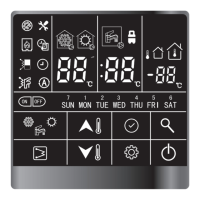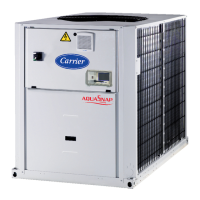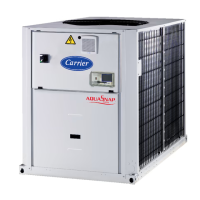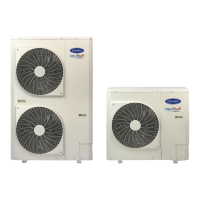5
Maxi 10%
Maxi 10%
Unit with grille protection option
The units can also be lifted with slings, using only the
designated lifting points marked on the unit (labels on the
chassis and a label with all unit handling instructions are
attached to the unit).
Use slings with the correct capacity, and always follow the
lifting instructions on the certied drawings supplied for the
unit.
Safety is only guaranteed, if these instructions are carefully
followed. If this is not the case, there is a risk of material
deterioration and injuries to personnel.
DO NOT COVER ANY PROTECTION DEVICES.
This applies to fuse plugs and relief valves (if used) in the
refrigerant or heat transfer medium circuits. Check if the
original protection plugs are still present at the valve outlets.
These plugs are generally made of plastic and should not be
used. If they are still present, please remove them. Install
devices at the valve outlets or drain piping that prevent the
penetration of foreign bodies (dust, building debris, etc.) and
atmospheric agents (water can form rust or ice). These
devices, as well as the drain piping, must not impair operation
and not lead to a pressure drop that is higher than 10% of the
control pressure.
Classication and control
In accordance with the Pressure Equipment Directive and
national usage monitoring regulations in the European Union
the protection devices for these machines are classied as
follows:
Safety
accessories
(1)
Over pressure
protection in case of
an external re
(2)
Refrigerant Side
High pressure switch x
External relief valve
(3)
x
Rupture disk x
Fuse plug x
Heat transfert uid side
External relief valve
(4) (4)
(1) Classied for protection in normal service situations.
(2) Classied for protection in abnormal service situations. These accessories are
sized for res with a thermal ow of 10kW/m². No combustible matter should be
placed within 6.5m of the unit.
(3) The instantaneous over-pressure limited to 10% of the operating pressure does
not apply to this abnormal service situation. The control pressure can be higher
than the service pressure. In this case either the design temperature or the
high-pressure switch ensures that the service pressure is not exceeded in normal
service situations.
(4) The selection of these discharge valves must be made by the personnel
responsible for completing the hydraulic installation.
Do not remove these valves and fuses, even if the re risk is
under control for a particular installation. There is no
guarantee that the accessories are re-installed if the
installation is changed or for transport with a gas charge.
When the unit is subjected to re, safety devices prevent
rupture due to over-pressure by releasing the refrigerant. The
uid may then be decomposed into toxic residues when
subjected to the ame:
- Stay away from the unit.
- Set up warnings and recommendations for personnel in
charge to stop the re.
- Fire extinguishers appropriate to the system and the
refrigerant type must be easily accessible.
All factory-installed relief valves are lead-sealed to prevent
any calibration change.
The external relief valves must always be connected to drain
pipes for units installed in a closed room (30RQSY). Refer to
the installation regulations, for example those of European
standard EN 378 and EN 13136.
These pipes must be installed in a way that ensures that
people and property are not exposed to refrigerant leaks. As
the uids can be diffused in the air, ensure that the outlet is
far away from any building air intake, or that they are
discharged in a quantity that is appropriate for a suitably
absorbing environment.
Relief valves must be checked periodically. See paragraph
“Repair safety considerations”.
If the relief valves are installed on a reversing valve
(changeover), this is equipped with a relief valve on each of
the two outlets. Only one of the two relief valves is in
operation, the other one is isolated. Never leave the reversing
valve in the intermediate position, i.e. with both ways open
(locate the control element in the stop position). If a relief
valve is removed for checking or replacement please ensure
that there is always an active relief valve on each of the
reversing valves installed in the unit.
Provide a drain in the discharge circuit, close to each relief
valve, to avoid an accumulation of condensate or rain water.
All precautions concerning handling of refrigerant must be
observed in accordance with local regulations.
Accumulation of refrigerant in an enclosed space can displace
oxygen and cause asphyxiation or explosions.
Inhalation of high concentrations of vapour is harmful and
may cause heart irregularities, unconsciousness, or death.
Vapour is heavier than air and reduces the amount of oxygen
available for breathing. These products cause eye and skin
irritation. Decomposition products can be hazardous.
1 - INTRODUCTION

